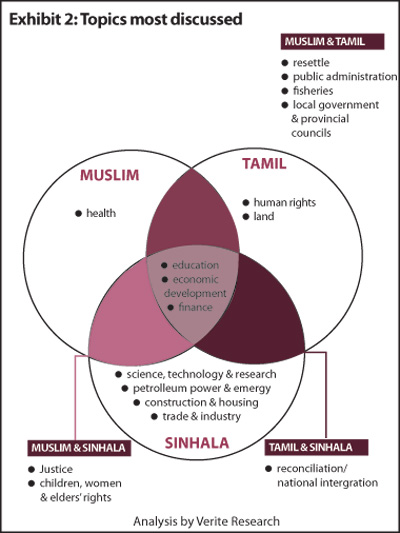News
Dialogue between ethnic parties in Parliament – is there convergence or divergence?
View(s): Half the political parties (11 of 21) in the Sri Lankan parliament can be termed ‘ethnic parties’: that is, explicitly or implicitly, they represent a specific ethnic group. To what extent do ethnic parties talk to each other and manage to advance inter-ethnic understanding?
Half the political parties (11 of 21) in the Sri Lankan parliament can be termed ‘ethnic parties’: that is, explicitly or implicitly, they represent a specific ethnic group. To what extent do ethnic parties talk to each other and manage to advance inter-ethnic understanding?
Manthri.lk is a pioneering online platform that monitors and ranks all the proceedings and actors in parliament. It tracks the extent and topical convergence of exchanges of the ethnic parties in parliament, and helps to answer the question.Ethnic Party Size is small: The total number of members in ethnic parties is 35. The average size of an ethnic party in parliament is 3 MPs, and ethnic parties can be categorised into three; namely, those they represent: Tamils, Muslims and Sinhalese.
Tamil parties – the largest and loudest: The largest of these groups are the Tamil parties, consisting of 20 MPs in total from seven parties (Exhibit 1); 12 from Illankai Tamil Arasu Kachchi (ITAK), and the others from Eelam People’s Democratic Party (EPDP), All Ceylon Tamil Congress (ACTC), Eelam People’s Revolutionary Liberation Front (EPRLF), Democratic People’s Front (DPF), National Union of Workers (NUW) and Ceylon Workers’ Congress (CWC). The average contribution from an MP in a Tamil ethnic party is also the highest among the three ethnic party groups.
Muslim parties – the quietest: Though second largest in terms of size, the Muslim parties are the quietest (Exhibit 1). They consist of 10 MPs from two parties; All Ceylon Muslim Congress (ACMC) and Sri Lanka Muslim Congress (SLMC). Sinhala parties – small but loud: The smallest of the group are the Sinhala parties, but they rival Tamil MPs in loudness. They consist of 5 MPs in total from two parties; Jathika Hela Urumaya (JHU) and National Freedom Front (NFF).
Convergence or divergence in dialogue?Exhibit 2 shows the convergences and divergences on topics addressed significantly by the ethnic parties. All three converge on three important topics: education, finance and economic development.
More Convergence between Muslim and Tamil Parties: The highest convergence of topics is between Muslim and Tamil parties, on topics that mostly relate to solving the grounded human and administrative problems of a post war population: resettlement, public administration, fisheries and local government and provincial councils.
Tamil and Sinhala Parties Converge in the Clouds: Sinhala parties converge with Tamil ethnic parties only on the conceptual issue of Reconciliation/National Integration, not on the grounded problems that are addressed by Muslim parties as well, or even on the governance problems of Human Rights and Land Distribution which are only addressed by Tamil parties. Likewise Tamil parties fail to converge with Sinhala parties on National policy issues such as Science & Technology, Energy, and Trade & Industry.
Is it good to have ethnic parties in parliament? What can be done to improve the quality and convergence of dialogue? SMS your comments to 071-463-9882 or leave a comment on facebook.com/Manthrilk.



